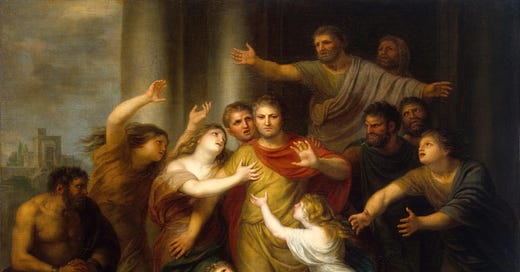Welcome to this week’s edition of Reading Art!
Last week, we looked at some portrayals of tyrannical leaders in Ancient Greece and the sticky ends that often awaited them. This week, I want to turn to Ancient Rome and focus on the ways in which various artists have envisioned Rome’s imperial power.
As a disclaimer, I want to note up front that Rome was a very violent and ruthless imperial power, and it had a number of cruel and authoritarian leaders. Today I want us to interrogate the ways in which the Romans fashioned themselves as an eternal global power, and the ways in which this image has been received and reflected by later artists.
The rise of Rome
Indeed, looking at some portrayals of Roman history and culture in early modern and modern art can be an interesting way of assessing Rome’s larger-than-life presence not only in its own day, but also in later eras.
Before we turn to the art, let’s talk history:
Roman imperialism is a vast and complex topic, and I won’t be able to dig into all the finer points today. As a brief summary: Rome had humble beginnings as a village along the Tiber River, and was said to have been founded in 753 BCE. For centuries after, they would use this date as a “starting point” for talking about time, describing events as ___ years “after the city was founded,” or ab urbe condita, which literally means “from the founding of the city” in Latin. But eventually Rome did rise to power, besting various opponents throughout the Mediterranean world and eventually conquering Greece before expanding throughout much of Europe, the Middle East, and North Africa.
To give you some idea of what I’m talking about, here’s a map of the Roman Empire in the second century CE. Things would shift around over time, but suffice to say that Rome controlled a large expanse of the known world at that time.
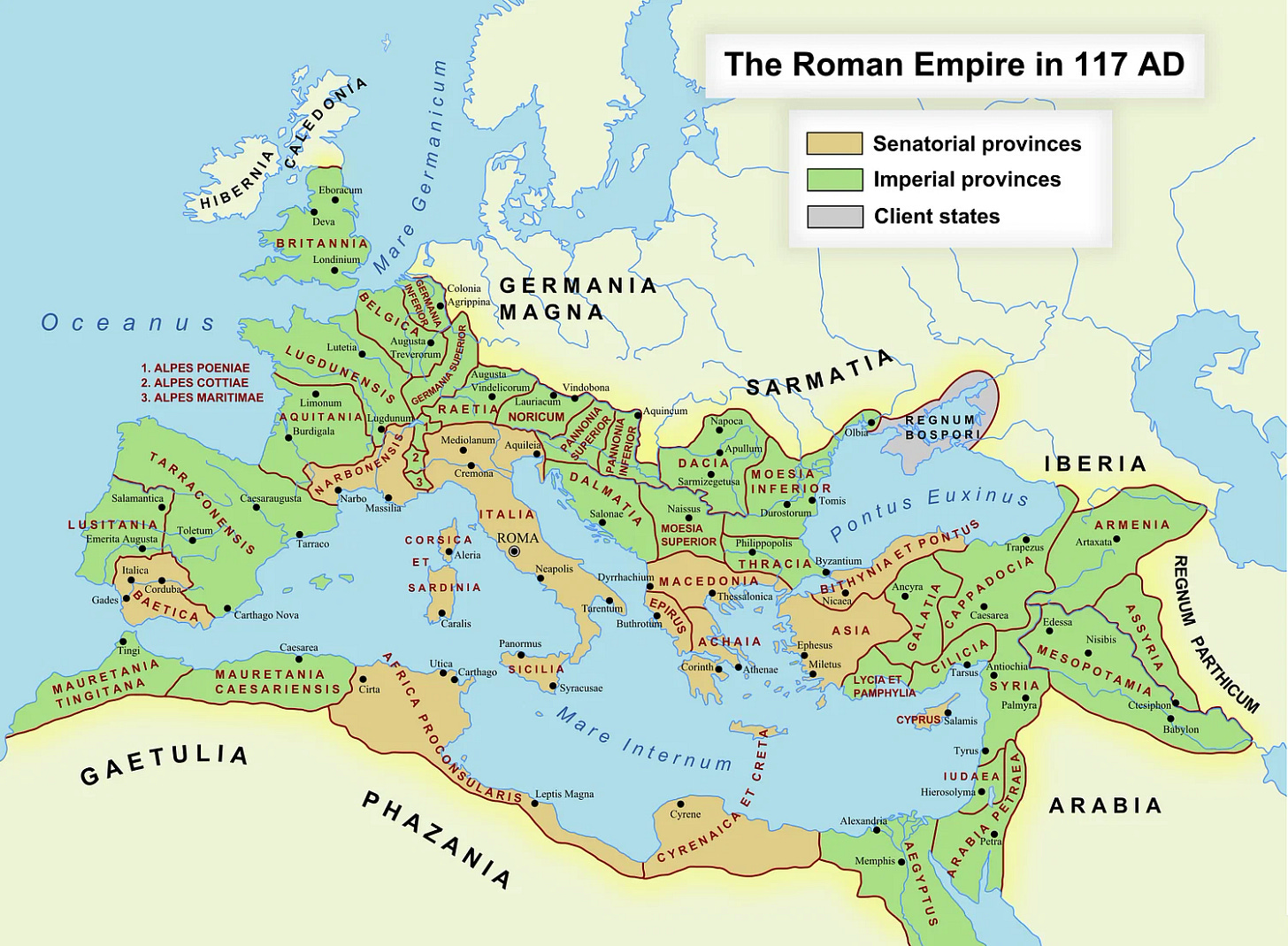
What all this means is that when we talk about “the Roman Empire,” we’re talking about a diverse and multicultural world. Yes, there were native Italians and those who spoke Latin as a first language, etc., but there were also people from all over the world living in Rome who had acquired Latin or Greek as a second/third language, too. And yet despite this Rome was eager to create a certain ideological similitude among all of its imperial subjects, a sense of “Roman” identity (and supremacy).
Morality and politics in early Rome
The Romans liked to believe that they were a people who embraced down-to-earth morals, and that the luxuries of Imperial life were detrimental to these “Roman” values. In the olden days of Rome, as Cicero and others like to brag, the highest compliment was to be “a good man and a good farmer.”
Even as the Roman emperors seemed to get crueler and more ruthless by the day, there was still a belief among both the Romans themselves and later generations that Roman righteousness was unstoppable.
This belief is reflected in various legends about early Roman statesmen, such as the tale of Marcus Atilius Regulus, who was Consul in 267 BCE. He was alive during the Punic Wars, a series of conflicts between Rome and Carthage (on the coast of North Africa). Rome ultimately won, but Carthage did manage to hold its own.
Anyway, Regulus was said to have been captured by the Carthaginians in battle, but then sent back to Rome under oath that he would broker some kind of hostage exchange. The true mark of his “Roman” righteousness was his refusal to negotiate with Carthage; he just wanted Rome to flatten the city. According to a story (which is probably not true, but had a big cultural impact), Regulus decided instead to defiantly march back to Carthage without having negotiated any kind of deal.
Cornelis Lens shows Regulus at the center here, determined to go back to Carthage, while everyone tries to stop him:
But Regulus is so filled with Roman national pride that he won’t be stopped, and was supposedly tortured and slain by the angry Carthaginians. (Historians think he actually died of natural causes, but that version of events wasn’t as good for moralizing to posterity.) Here, the intensity of his gaze speaks to his desire to destroy Carthage utterly, and he seems to look into a future in which Carthage has already been crushed beneath Rome’s feet. Even his own family’s despair can’t keep him from sticking it to his enemies one last time.
Unfortunately for him, he was the one who got crushed. Here’s Regulus in a Medieval manuscript, being flattened to death by the Carthaginians, here re-envisioned as Medieval Europeans(!?):
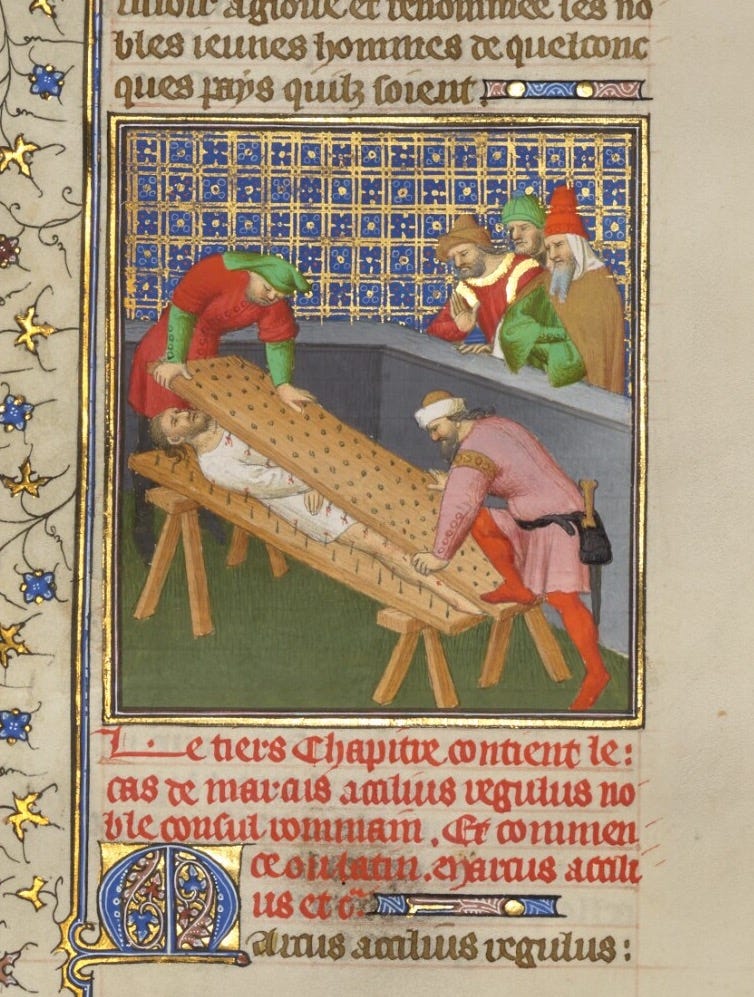
But were the Romans really the better party here? They had an intense hatred for Carthage that seemed to go beyond political ambition; Cato the Elder, a notable Roman politician, was said to have ended every speech he gave with the words Carthago delenda est! Which means—you guessed it—Carthage must be destroyed!
In other words, to study the Romans is to be stuck in a perpetual state of cognitive dissonance between their self-image as a humble and upstanding people and the realities of their prejudices and capacity for brutality.
Even Rome’s earliest beginnings are problematic: after all, the legendary founders of the city, twin sons of Mars Romulus and Remus, were so blinded by a desire for power that they were willing to kill one another to get it—and Romulus did indeed kill Remus. That’s why it’s called Rome. (What would it have been called if Remus won the fight? Reme?)
In this engraving from the sixteenth century, Rome’s brave founder slays his own brother:

The motif might have appealed to Fontana and others of his era because of the parallel to the biblical story of Cain and Abel. Unlike Cain, however, Romulus was upheld as a major cultural hero and even deified after his death. But his actions weren’t always so virtuous. For example, when he realized his new city was populated almost entirely by men, he decided to kidnap the woman of the Sabine people, a neighboring community.
The jam-packed figures of Girolamo del Pacchia’s portrayal really gets at the chaos of the scene:
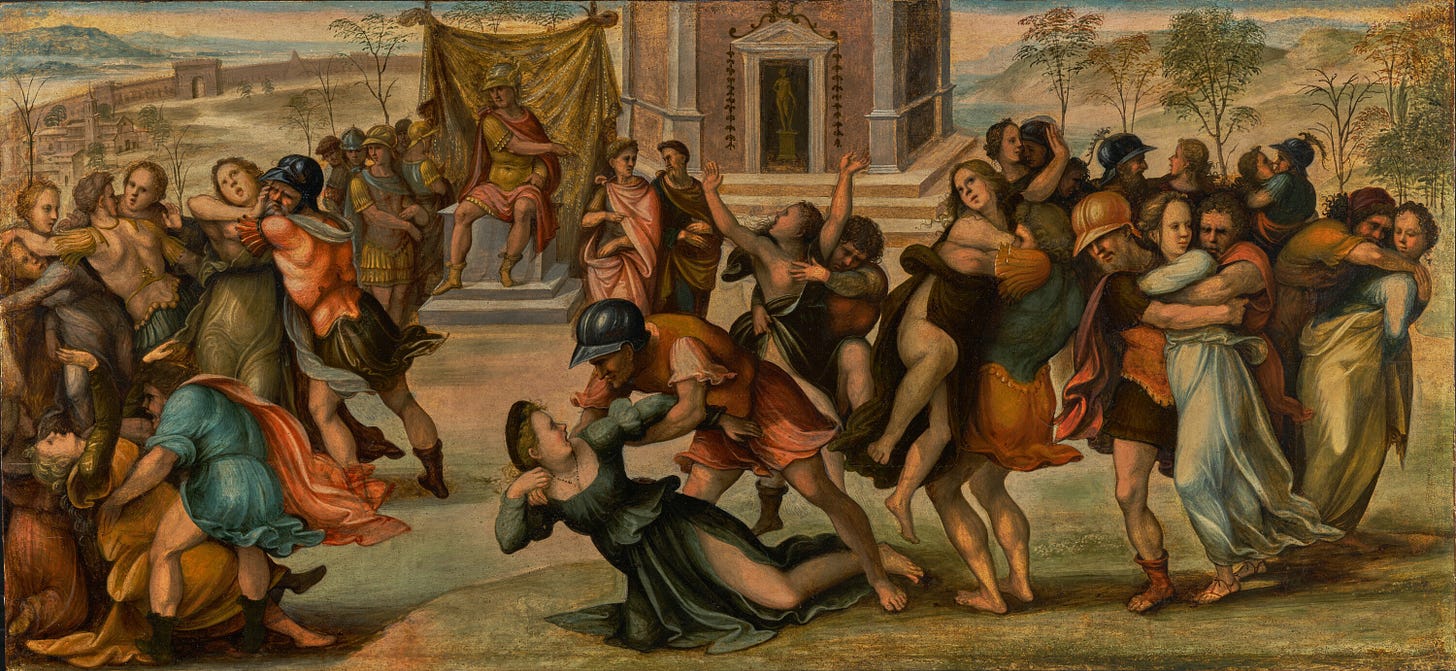
In one of the most problematic episodes of Roman history—and that’s saying a lot—the Sabine women eventually fell prey to Stockholm syndrome and convinced their angry parents not to do battle with the Romans, which they were willing to do to get them back. Yet, like Regulus, Romulus and his men look into a future in which their violence is, in their eyes, justified because of the results it achieves. In Pacchia’s painting, Romulus sits in the background on a makeshift throne, secure in the knowledge that he will get what he wants: to be the god-king of the powerful city that he founded.
Hail, Philosophia
Part of my dissertation argues that, in the antique and early modern periods, intellectual culture was also framed as a quasi-imperial force with the power to assimilate different groups into one seemingly cohesive whole. There are some interesting suggestions of this in material culture. One of my favorite examples is the way in which personified Philosophy was portrayed in the sixteenth century:
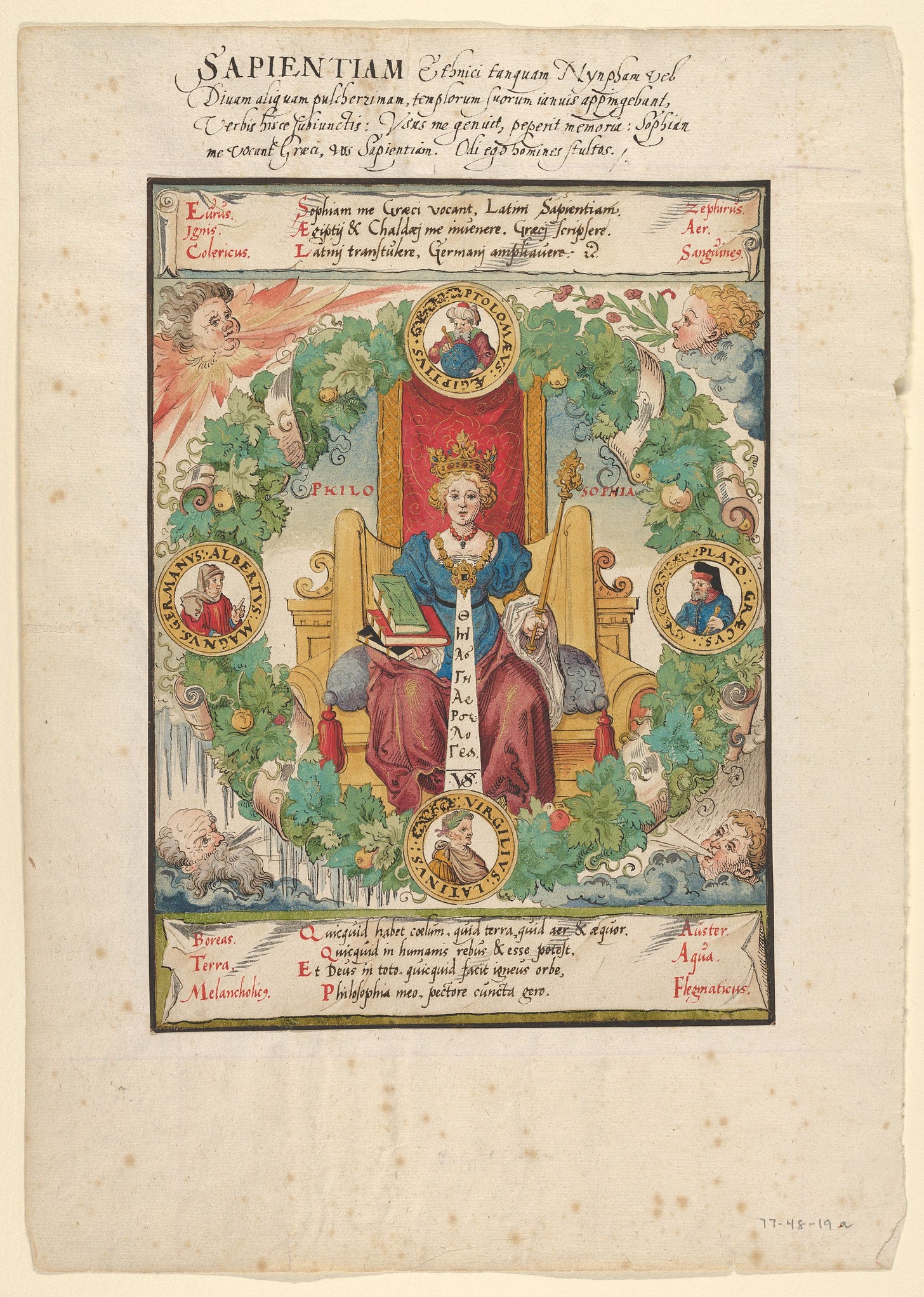
This was a common way of conceptualizing personified Philosophy in the early modern period. Here’s another very similar example by Dürer:
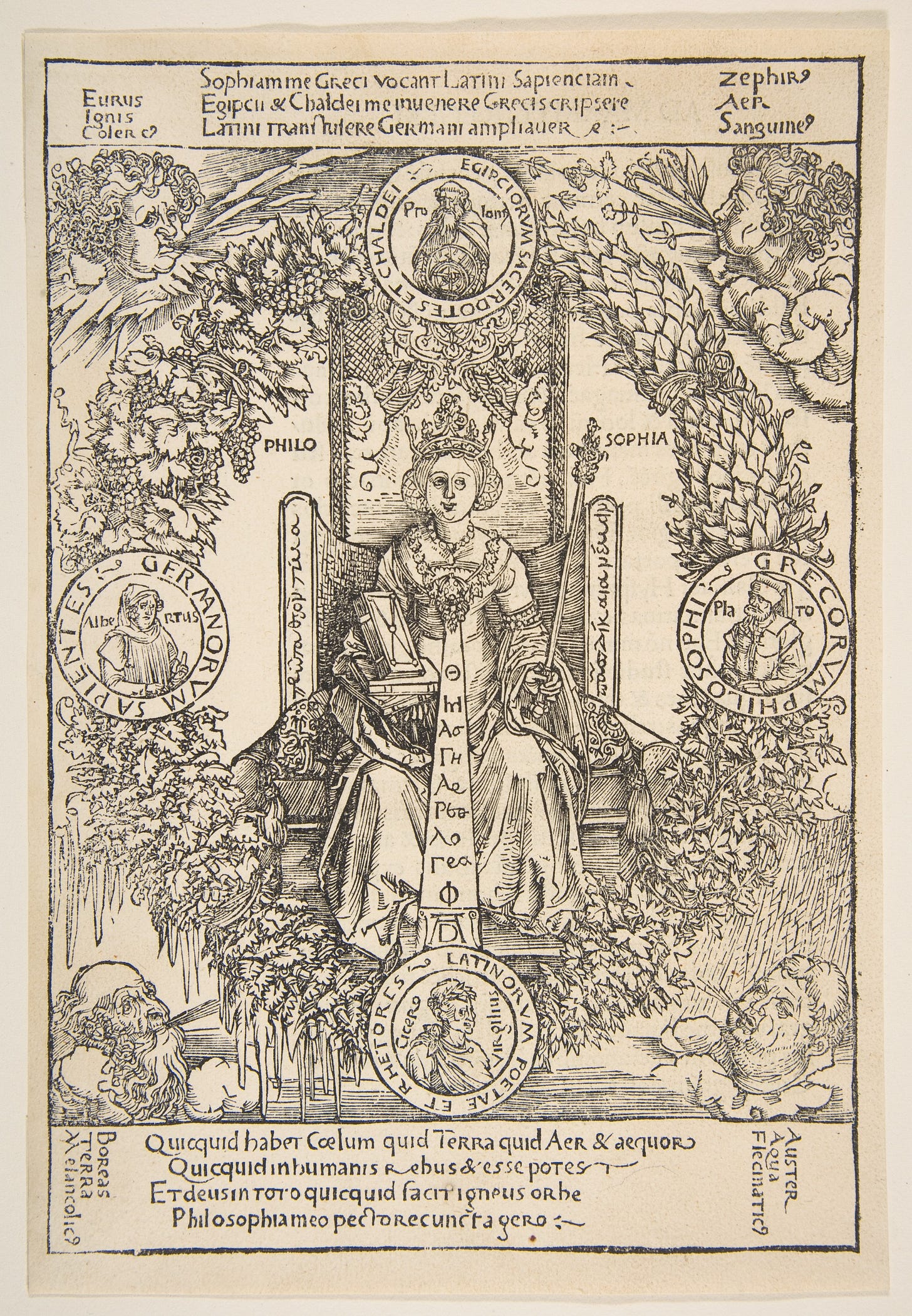
Queen Philosophy is surrounded by emblems of the intellectual triumphs of various cultures and time periods: at her feet, forming a foundation, are the “poets and orators of the Romans,” represented by Cicero and Vergil. To her right are the “wise men of Germany,” represented by Albertus Magnus. Above her head are the “priests and sages of the Egyptians,” represented by Ptolemy. Finally, to her left are the “Greek philosophers,” represented by Plato. The presence of the Four Winds further suggests that her sphere of influence extends not only across time periods and fields of study, but also across the globe. The inscription at the bottom, speaking in the first person from Philosophy’s perspective, reads as follows: “Whatever heaven holds, whatever the earth, and whatever the air, and the sea, whatever is able to exist in human affairs, and whatever the fiery god does in the entirety of the world, I, Philosophy, hold these things within my breast” (Quicquid habet Caelum quid Terra quid Aer & aequor / Quicquid in humanis rebus& esse potest / et deus in toto quicquid facit igneus orbe / Philosophia meo pectore cuncta gero).
Here, Rome isn’t necessarily put front-and-center, but is rather just one component of Philosophy’s empire, which does not seem to be bound by either space or by chronological time.
Philosophy looks out upon the nations of the world with what Mary Louise Pratt (2008) has called “imperial eyes.” This refers to a sort of implicit self-assurance that everywhere has already been conquered and brought under the sway of one’s own culture. When I look at the works above, I see Regulus, Romulus, and Philosophy all looking out with these same “imperial eyes,” even if they do so in different ways. Regulus and Romulus were concerned with physically dominating the world, but Philosophy takes a different approach: uniting all under the auspices of philosophical wisdom. What would this actually entail? Is it possible for ideology to be a unifying force when global imperialism has already occurred? If we accept Philosophy as god-emperor of the entire world, where does that leave the Romans, or any other of the cultures encompassed in Philosophy’s sphere of influence? There are no easy answers to these questions, of course, but they make me think back on Regulus and even Romulus, so sure they were doing the right thing by perpetuating a cycle of violence in the name of glory. Philosophy promises a bloodless rule—or, rather, would allow us to forget the bloodshed of the past. But we know this is a fantasy, an unreality.
Imperial Eyes
In other cases, it is the viewer—or possibly even the artist—of the work and not the subject who is made to look out with these “imperial eyes.” One such example is this painting, entitled Modern Rome—Campo Vaccino, painted by British artist Joseph Mallard William Turner in 1839:
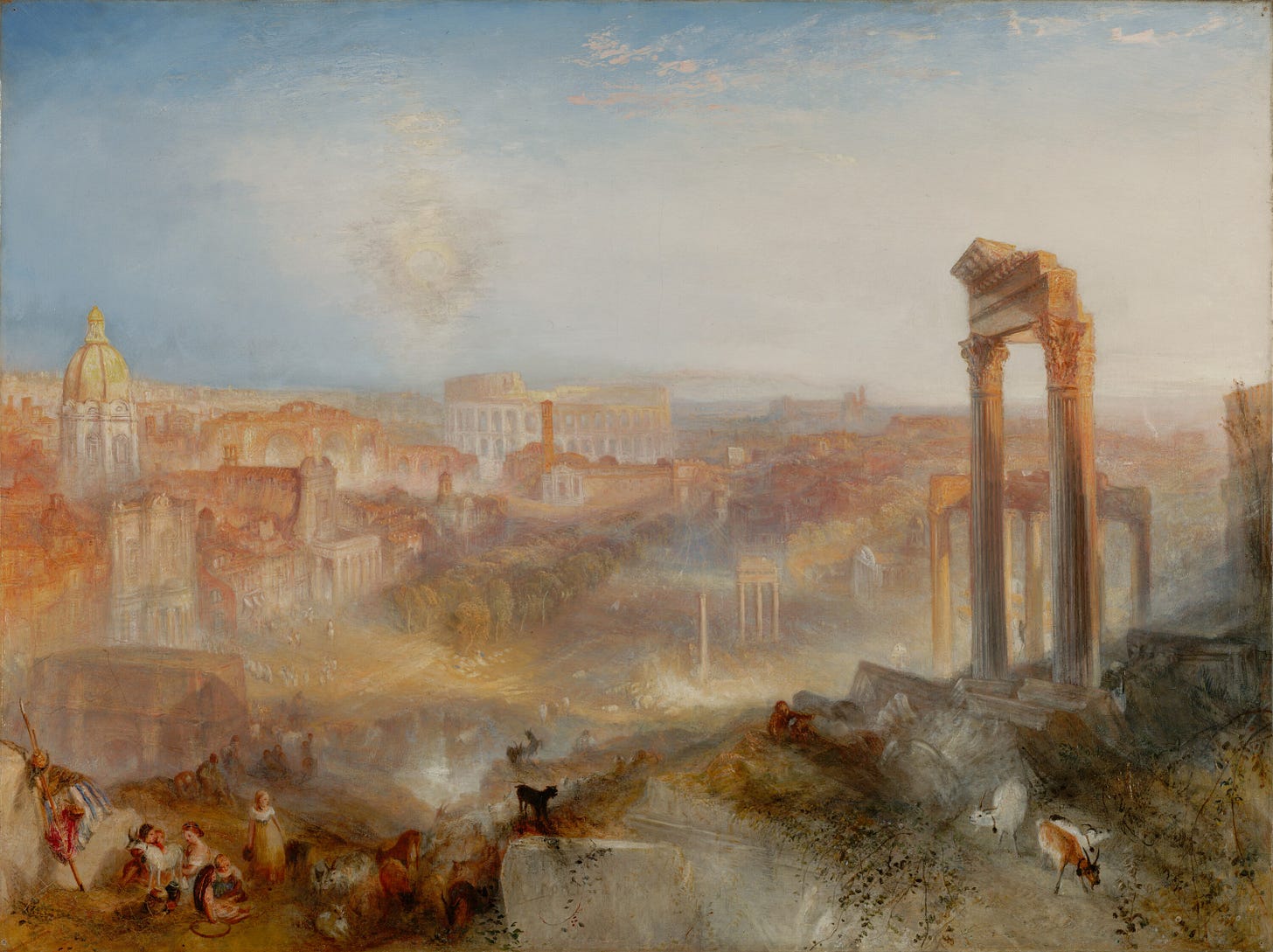
The title “Modern Rome” in combination with the misty ruins and the few tiny figures in the lower lefthand corner make it seem like Rome is a thing of the past. And, technically, it was! The Roman Empire was indeed no more. But given Britain’s thirst for imperial expansion in the seventeenth and eighteenth centuries, I can’t help but wonder whether Turner himself was looking out with his own imperial gaze and prompting the reader to do the same. As I discussed in a post from a few weeks back, the Brits often sought inspiration from the Roman Empire when engaging in their own empire-building: here, the sun might be setting on Rome, but, within a century of Turner’s time, it would never set on the British Empire.
The description from Getty provides some fascinating insight into the cultural context of this piece:
When first exhibited at the Royal Academy in 1839 with its pendant, Ancient Rome; Agrippina Landing with the Ashes of Germanicus, the painting was accompanied by a modified quotation from Lord Byron's masterpiece, Childe Harold's Pilgrimage (1818): "The moon is up, and yet it is not night, / The sun as yet divides the day with her." Like the poem, Turner's painting evokes the enduring sublimity of Rome, which had been for artists throughout history less a place in the real world than one in the imagination.
To me, even the accompanying quotation seems to suggest that Rome’s legacy is in a liminal state, half-day and half-night. Whenever we stop to appreciate its rich culture and history, we also have to acknowledge its problematic aspects as well. This is just the reality of studying the past.
Thank you for reading this week’s edition of Reading Art!
It was interesting to look at the ways in which imperial expansion is both glorified and problematized in art. No easy conclusions today! But lots of things to think about. As ever, I would love to hear your thoughts. Take care until next time.
MKA

